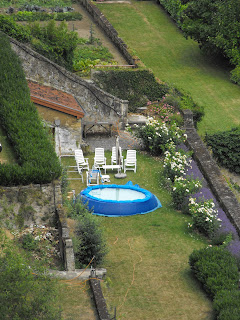 To describe a city--in this case, the capital of Luxembourg--as a garden in the singular is, admittedly, a bit excessive. Perhaps we can attribute hyperbolic description to jet lag (though sleeping quite late today by European standards most likely cured me of the time difference). Or perhaps we can attribute the description to geographic, climactic, and historic specters of reality that frame the experience of life in Luxembourg City.
To describe a city--in this case, the capital of Luxembourg--as a garden in the singular is, admittedly, a bit excessive. Perhaps we can attribute hyperbolic description to jet lag (though sleeping quite late today by European standards most likely cured me of the time difference). Or perhaps we can attribute the description to geographic, climactic, and historic specters of reality that frame the experience of life in Luxembourg City.By "other people's gardens: Luxembourg City" I do not mean to suggest that the city is a grand horticultural bazaar, though one can find lovely botanical arrangements in all of the appropriate sites: in boxes along outdoor cafes; along the gorges that traverse through the heart of the city; near the Palais Grand-Ducal (residence of the Duke of Luxembourg); near government ministries (I walked into the gated compound of the Presidential Offices); and, for this part of the world, at sites of ill repute which are always associated with war (near our hotel, the Place de Martyrs, site of the rounding up of Nazi victims).
 Rather, I mean to describe this ineffable beauty created by the backdrop of history (14th - 17th century ramparts and bridges, turrets and ponts). Terraced gardens proliferate along the gorges that frame the magnificent Ville Haute, truly a "City on the Hill" in the strictest geographic sense. These most captivated me, and I became slightly envious with the material these gardeners have at their fingertips. Imagine: your climbing hydrangea sprawling up the remains of a bridge constructed in 1395! Imagine your vegetables and herbs (not to mention a few grapes) growing up the sides of the famous casemates--an immense underground military defense system built by the Spanish (who, thanks to marital land swaps, ruled this land) in 1644, but under the already established 10th century fortress constructed by Count Sigefroy.
Rather, I mean to describe this ineffable beauty created by the backdrop of history (14th - 17th century ramparts and bridges, turrets and ponts). Terraced gardens proliferate along the gorges that frame the magnificent Ville Haute, truly a "City on the Hill" in the strictest geographic sense. These most captivated me, and I became slightly envious with the material these gardeners have at their fingertips. Imagine: your climbing hydrangea sprawling up the remains of a bridge constructed in 1395! Imagine your vegetables and herbs (not to mention a few grapes) growing up the sides of the famous casemates--an immense underground military defense system built by the Spanish (who, thanks to marital land swaps, ruled this land) in 1644, but under the already established 10th century fortress constructed by Count Sigefroy.Most of the private gardens that I have encountered have been formal: perhaps owing to the diminutive plots in a diminutive country, or perhaps owing to the predominant French cultural influence. No matter: the result is spectacular, and, curiously, the formality of garden design melds with the more relaxed feel of the city, the country, and the people.
The sense of possibility is heightened (pun intended) by the grandeur of the gorges, the spires of cathedrals, and the magnitude of the blue skies. Purples, yellows, spikes of yellow, roses and alliums, mosses and ferns, horse chestnut and catalpa tress in full bloom: the garden that is Luxembourg City beckons.


Lovely photos!
ReplyDelete